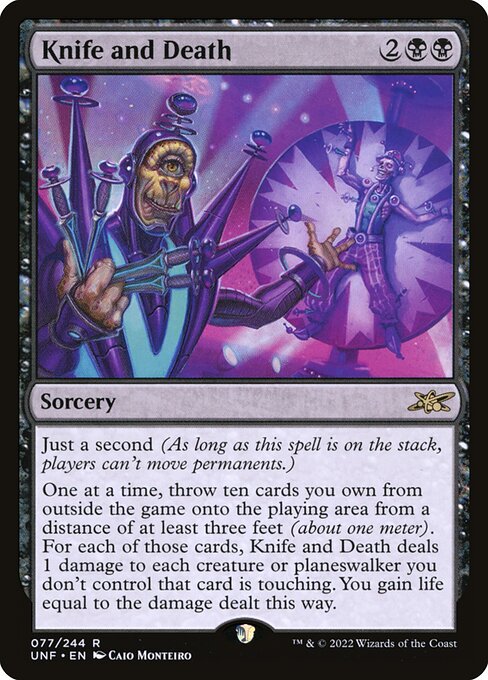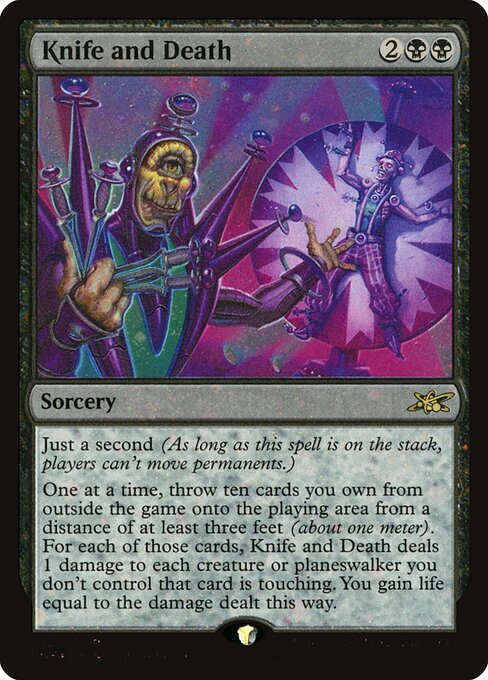Knife and Death
Sorcery
Just a second (As long as this spell is on the stack, players can't move permanents.)
One at a time, throw ten cards you own from outside the game onto the playing area from a distance of at least three feet (about one meter). For each of those cards, Knife and Death deals 1 damage to each creature or planeswalker you don't control that card is touching. You gain life equal to the damage dealt this way.
One at a time, throw ten cards you own from outside the game onto the playing area from a distance of at least three feet (about one meter). For each of those cards, Knife and Death deals 1 damage to each creature or planeswalker you don't control that card is touching. You gain life equal to the damage dealt this way.
standard
future
historic
gladiator
pioneer
explorer
modern
legacy
pauper
vintage
penny
commander
brawl
alchemy
paupercommander
duel
oldschool
premodern
Rulings
The ten cards must be traditionally sized Magic cards. They can be in card sleeves if you’d like, but not otherwise modified. They must be thrown onto the battlefield from at least three feet (about one meter) away horizontally.
The thrown cards never actually enter the game. After Knife and Death finishes resolving, they return from whence they came, to thine sideboard or collection.
If one of the cards ends up touching the object used to represent a creature or planeswalker token an opponent controls, Knife and Death will deal damage to it.
Knife and Death considers only the creatures and planeswalkers any of the ten cards are touching after you have thrown the tenth card and all cards stop moving. It’s possible that a card will land touching a creature but then will be knocked off that creature by a later throw. That is, assess damage only after all knives . . . er, cards have been thrown.
If a thrown card ends up touching more than one creature or planeswalker you don’t control, Knife and Death will deal 1 damage to each of them. You’ll gain 1 life for each of them. Knife and Death won’t deal damage to creatures or planeswalkers you control that get hit, and you won’t gain life for them either.
Card sleeves are considered part of the card. If a thrown card (or its own card sleeve) is touching another card’s sleeve, it is considered touching that card.
No player may interfere with the throwing of the ten cards, including while they’re in flight.
Just a second is a variant of split second. Announcing Knife and Death instantly locks all permanents in place on the battlefield. As long as Knife and Death is on the stack, players can’t cast spells, activate abilities, or move their permanents.
The thrown cards never actually enter the game. After Knife and Death finishes resolving, they return from whence they came, to thine sideboard or collection.
If one of the cards ends up touching the object used to represent a creature or planeswalker token an opponent controls, Knife and Death will deal damage to it.
Knife and Death considers only the creatures and planeswalkers any of the ten cards are touching after you have thrown the tenth card and all cards stop moving. It’s possible that a card will land touching a creature but then will be knocked off that creature by a later throw. That is, assess damage only after all knives . . . er, cards have been thrown.
If a thrown card ends up touching more than one creature or planeswalker you don’t control, Knife and Death will deal 1 damage to each of them. You’ll gain 1 life for each of them. Knife and Death won’t deal damage to creatures or planeswalkers you control that get hit, and you won’t gain life for them either.
Card sleeves are considered part of the card. If a thrown card (or its own card sleeve) is touching another card’s sleeve, it is considered touching that card.
No player may interfere with the throwing of the ten cards, including while they’re in flight.
Just a second is a variant of split second. Announcing Knife and Death instantly locks all permanents in place on the battlefield. As long as Knife and Death is on the stack, players can’t cast spells, activate abilities, or move their permanents.
Rulings
The ten cards must be traditionally sized Magic cards. They can be in card sleeves if you’d like, but not otherwise modified. They must be thrown onto the battlefield from at least three feet (about one meter) away horizontally.
The thrown cards never actually enter the game. After Knife and Death finishes resolving, they return from whence they came, to thine sideboard or collection.
If one of the cards ends up touching the object used to represent a creature or planeswalker token an opponent controls, Knife and Death will deal damage to it.
Knife and Death considers only the creatures and planeswalkers any of the ten cards are touching after you have thrown the tenth card and all cards stop moving. It’s possible that a card will land touching a creature but then will be knocked off that creature by a later throw. That is, assess damage only after all knives . . . er, cards have been thrown.
If a thrown card ends up touching more than one creature or planeswalker you don’t control, Knife and Death will deal 1 damage to each of them. You’ll gain 1 life for each of them. Knife and Death won’t deal damage to creatures or planeswalkers you control that get hit, and you won’t gain life for them either.
Card sleeves are considered part of the card. If a thrown card (or its own card sleeve) is touching another card’s sleeve, it is considered touching that card.
No player may interfere with the throwing of the ten cards, including while they’re in flight.
Just a second is a variant of split second. Announcing Knife and Death instantly locks all permanents in place on the battlefield. As long as Knife and Death is on the stack, players can’t cast spells, activate abilities, or move their permanents.
The thrown cards never actually enter the game. After Knife and Death finishes resolving, they return from whence they came, to thine sideboard or collection.
If one of the cards ends up touching the object used to represent a creature or planeswalker token an opponent controls, Knife and Death will deal damage to it.
Knife and Death considers only the creatures and planeswalkers any of the ten cards are touching after you have thrown the tenth card and all cards stop moving. It’s possible that a card will land touching a creature but then will be knocked off that creature by a later throw. That is, assess damage only after all knives . . . er, cards have been thrown.
If a thrown card ends up touching more than one creature or planeswalker you don’t control, Knife and Death will deal 1 damage to each of them. You’ll gain 1 life for each of them. Knife and Death won’t deal damage to creatures or planeswalkers you control that get hit, and you won’t gain life for them either.
Card sleeves are considered part of the card. If a thrown card (or its own card sleeve) is touching another card’s sleeve, it is considered touching that card.
No player may interfere with the throwing of the ten cards, including while they’re in flight.
Just a second is a variant of split second. Announcing Knife and Death instantly locks all permanents in place on the battlefield. As long as Knife and Death is on the stack, players can’t cast spells, activate abilities, or move their permanents.
Your collection? Your decks?
Want to manage your collection and/or create decks?



 0
0
 0.21€
0.21€